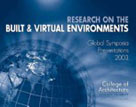| |
Faculty symposium
showcases research

Daylong event included more than 40 presentation
from international venues
| |
|
The College of Architecture at Texas A&M University held its fifth annual faculty research symposium, “Research on the Built and Virtual Environments: Global Symposia Presentations 2003,” on Monday, October 27 at the Langford Architecture Center on the Texas A&M campus.
The daylong research showcase featured a series of faculty presentations previously delivered at scholarly venues around the world. The 2003 symposium included invited or refereed presentations from the 2002-03 academic year.
As in previous years, the symposium covered a diverse range of topics concerning the built and virtual environments. The 12 sessions on the 2003 agenda included: “energy and conservation,” “construction technology,” “architectural theory,” “past, present and future practices,” “history and historical preservation,” “health design and issues,” “urban planning,” “hazards and planning,” “visualization and the arts,” “computers and design,” “sustainability,” and “education.”
“The College of Architecture’s annual symposium provides a unique opportunity to learn about our faculty’s diverse research initiatives,” said J. Thomas Regan, dean of the College of Architecture. “The 2003 event featured over 40 presentations selected from more than 200 papers presented last year at home and abroad. In the five years since we began the symposium,” Regan continued, “our faculty has traveled the globe, presenting their work at academic events in approximately 41 nations and 44 states in the United States.”
Highlighting the Oct. 27 symposium was a keynote address by Dennis E. Wenger, director of the National Science Foundation’s Infrastructure Systems Management and Hazard Response Program. A member of the College of Architecture faculty and founding director of A&M’s Hazard Reduction and Recovery Center, Wenger was appointed to the NSF’s Division of Civil and Mechanical Systems in 2001. As director, he oversees all social scientific research on natural, technological and human-induced disasters.
A distinguished scholar and noted speaker in the area of disaster management, Wenger has been involved in disaster and civil disorder research for over 30 years. His after-lunch keynote presentation was entitled, “Basic Scientific Research: Challenge and Opportunity.”
To facilitate the symposium and encourage student participation, the College of Architecture suspended all scheduled classes and studios on the day of the event.
"It is unusual for a college such as ours to take 'time out' from our usual schedule of classes, design studios and meetings to hear our colleagues report on their current research," Regan said. "Too often, faculty colleagues and graduate students are left at home when one of us travels to a distant symposium to deliver the latest in our thinking on a timely topic. It is fitting in our role as the largest college of our kind in the nation to establish new traditions, such as this one, that couple scholarly research solidly with professional education."
“One organizing principle of the College of Architecture is the influence of research on teaching,” the dean continued. “This annual symposium is a catalyst for the research-informed teaching that distinguishes us in all 12 of our degree programs.”
| |
 View slide show
View slide show
|
|
| |
|
|